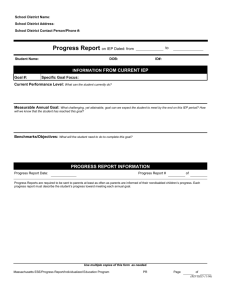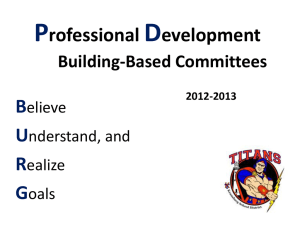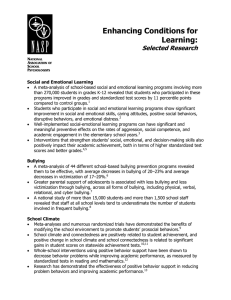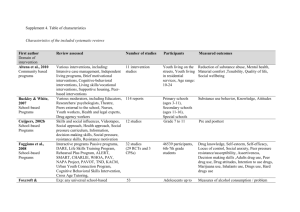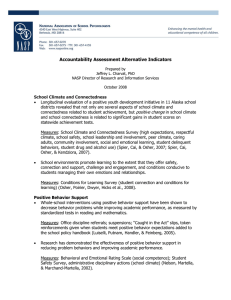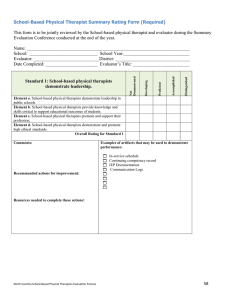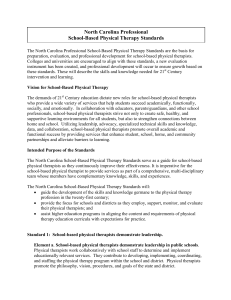The Speech Language Pathologist's Role in Schools
advertisement
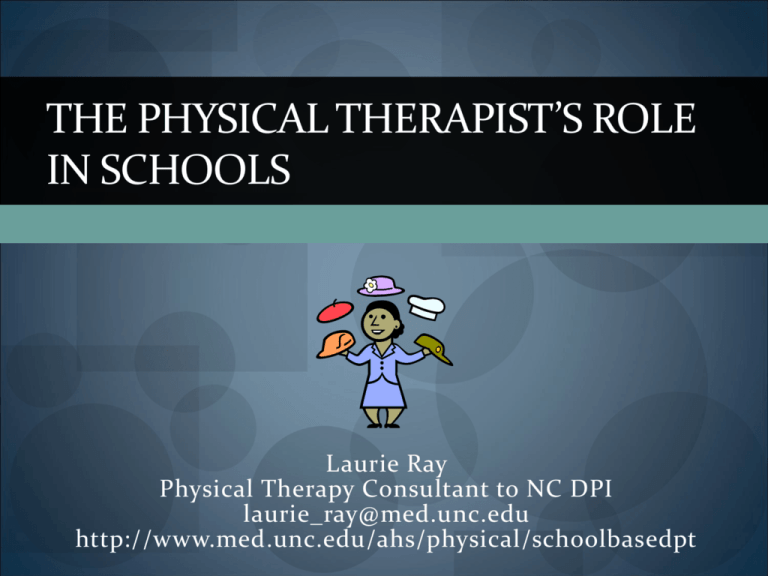
THE PHYSICAL THERAPIST’S ROLE IN SCHOOLS Laurie Ray Physical Therapy Consultant to NC DPI laurie_ray@med.unc.edu http://www.med.unc.edu/ahs/physical/schoolbasedpt (This is powerpoint is intended to be used as a tool by you to adapt and change for you to use your school system.) Objective To orient teachers, teacher assistants, school staff , principals, parents and other administrators to the potential roles of School-based Physical Therapists (SBPTs) in schools To indicate how best to use SBPTs as a resource. Related Service? Physical Therapy is one of the related services under Part B of IDEIA. School-based physical therapy services must be related to an educational need. To receive school-based PT, a student must qualify for special education and need the service to: achieve their IEP goals and/or access to and participate in the educational environment Related services are not provided because there is a transportation problem or other obstacle in getting outpatient or home based physical therapy. Community and School-based Services: It’s not an either/or situation.. Some children should receive services under more than one model. The frequency or intensity of physical therapy they receive in one setting may not meet all of the child's needs for PT. Some goals may not be addressed through schoolbased services & may require home or community services. In each setting, the child should be assessed individually to determine the best way to meet his or her needs. From start to finish! Accept referrals Conduct assessments Participate in Student Assistance Team or RtI initiatives Plan interventions Carry out interventions Document services Collaborate with and educate families, teachers and other staff Share assessment results with Individual Education Program (IEP) Teams Referral SBPTs can collaborate with teachers to promote activity and motor skills into their classrooms and class routines. If interventions are successful, the SBPT remains available for questions or consultation. If interventions are not successful the process for referral to Special Education is initiated. Assessment SBPTs use a variety of assessment tools NOT just standard tests. We do: Observations throughout the campus and student’s day Checklists Formal and informal testing of motor skills and function Interview teachers, parents, student and other staff Collect any student data that already exists Assessments are performed for all parties (parents, administrators, teachers….. ) to learn more about a student. Eligibility for Special Education Three Prongs The student is a ‘student with a disability’. 2. The disability adversely affects educational or functional performance at school. 3. The performance deficits related to the disability are such that the student requires specially designed instruction in order to ensure access to the general curriculum. 1. Individuals with Disabilities Education Improvement Act (2004) Assessment, Goals & Services Don’t get the… before the….. Serving Students There is no eligibility for a related service. Once goals are developed, the IEP team determines what services are needed in order to meet the IEP goals and for the student to make progress. The Individuals with Disabilities Education Improvement Act (IDEA 04) and NC Policies that Govern Services for Children with Disabilities say Special Education BEGINS in regular education settings then moves to more restrictive environments Determining School-based Services and Supports What is needed for the student to: Advance appropriately toward attaining goals Be involved and progress in the general curriculum Participate in non academic activities (including extracurricular) Be educated and participate with other students with and without disabilities What Do PTs Do in Schools? Work with students directly on motor and safety skills to improve mobility and independence Work with staff to facilitate the student’s participation in class activities and ensure staff safety Work to assist students’ access to their curriculum, extra curricular activities, their classroom, bus, school and school grounds Consult for facility planning and transition planning (work sites, community access and plans for after graduation) School-based Physical Therapist (SBPT) Involvement on a Programmatic Level Architectural barriers and plan for modifications and new construction Transportation Promote interaction with peers Recreational areas (consultation for playgrounds/equipment) Safety and prevention policies, activities and procedures (evacuation, good body mechanics, health promotion) General environmental modifications to promote independence and sound ergonomics Things we WANT to do Collaborate with teachers Serve students in classrooms, regular education, resource, self contained classes, in extra curricular activities (clubs, teams, etc.) As a part of a transition plan serve students on work sites, in the community Contribute our knowledge to student assistance teams, facility boards, renovation teams, curriculum teams Consult with other staff members on Essential Standards (Standard Course of Study) Related Services Related services are not ‘good for a lifetime’. We set goals, work to meet them, and work ourselves out of a job as students are able to participate in their school day without our support. The Related Service Support Description, a new part of the IEP, helps related service providers document services we provide on behalf of students Often, there are more effective ways to serve students other than direct therapy by increasing opportunities for daily practice by enriching their daily routines. Generalizing Skills Research has proven that many students do not carry over skills taught in isolation or learned with an adult to use on the playground or with their peers. Skills taught where those skills are used (in classrooms, on work sites, in the cafeteria, playground), require no ‘carry over’ to a new setting with new people. This is why it is best practice for school-based therapists to serve students where they are. What roles do pediatric PTs occupy? Problem solver Coordinator Communicator Consultant Service provider MAKE FRIENDS WITH YOUR SBPT!! We want to help you and help ALL children succeed!! Comments, Questions??




